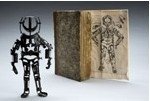Two exhibitions
dal 27/11/2009 al 27/2/2010
Segnalato da
Damien Hirst
Gilles Barbier
Patricia Piccinini
Tellervo Kalleinen
Oliver Kochta-Kalleinen
27/11/2009
Two exhibitions
Mori Art Museum, Tokyo
Medicine and Art: Imagining a Future for Life and Love. Leonardo Da Vinci, Okyo, Damien Hirst. Consisting of around 150 valuable medical artifacts from the Wellcome Collection and around 30 works of old Japanese and contemporary art, the exhibition presents an integrated vision of medicine and the arts, science and beauty. The show is a unique attempt to reconsider the science's role in health and happiness and also the meaning of human life and death.Tellervo Kalleinen and Oliver Kochta-Kalleinen. The artists visit a city and invite people to complain as much as they like and to sing about their complaints with other complainers in a choir.

Medicine and Art: Imagining a Future for Life and Love. Leonardo Da Vinci, Okyo, Damien Hirst
For most human beings their own body represents both the most familiar and most unknown of worlds. From ancient times humans have sought to unravel the secret mechanisms of the body, developing in the process a wealth of medical expertise. At the same time we have seen our own bodies as vessels for the representation of ideals of beauty, and long sought to depict our bodies in paintings and drawings. Leonardo da Vinci, who went so far as to dissect human bodies in order to make more accurate depictions of them, is perhaps the single creator whose output best embodies the integration of the scientific and artistic aspects of the body.
This exhibition, with its theme of "the human body as the meeting place of science (medicine) and art," was made possible with the cooperation of the Wellcome Trust, the world's largest independent charity funding research into human health. Consisting of around 150 valuable medical artifacts from the Wellcome Collection and around 30 works of old Japanese and contemporary art, the exhibition presents an integrated vision of medicine and the arts, science and beauty. The show is a unique attempt to reconsider the science's role in health and happiness and also the meaning of human life and death. A highlight of the exhibition is three anatomical sketches by Leonardo da Vinci from the Royal Collection, owned by Queen Elizabeth II.
Part I: Discovering the Inner World
Exhibits include the records and results of centuries of scientific inquiry along with historical medical artifacts and works of contemporary art.
Part 2: Fighting Against Death and Disease
Fighting Against Death and Disease
Here we ask how humans perceive death and disease, and how we have tried to fight against it. In addition to the history of medicine, pharmaceuticals and life sciences, we present various images related to old age and sickness, life and death.
Part 3: Toward Eternal Life and Life
In light of the latest developments in biotechnology, cybernetics and neuroscience, and with reference to medical materials and works of art, we pose the question: Considering reproduction is simply the endless repetition of the life-death cycle, what really motivates humans to reproduce?
------
Tellervo Kalleinen and Oliver Kochta-Kalleinen
Calling for members of the "Complaints Choir"!
Unspoken anxieties hang heavily over contemporary society: What does the future hold? When will politics gain some transparency? Another common anxiety is not knowing how to express your anxieties! Now there is an art project, "Complaints Choir," which promises to turn all this negative energy into positive energy through the medium of song. If you've got a complaint and you'd like to sing out loud about it, now is the time to join up.
"Complaints Choir," was launched in 2005 in Birmingham, England, by Helsinki-based artists Tellervo Kalleinen (born 1975, Lohja, Finland) and Oliver Kochta-Kalleinen (born 1971, Dresden, former East Germany.) Since then it has been held in many cities around the world. It works something like this: The artists visit a city and invite people to complain as much as they like and to sing about their complaints with other complainers in a choir. The choir members decide collectively on the lyrics for the song which is composed by a local musician who arranges those complaints with a rousing piece of music, and then, after several rehearsals, present the song in a public location.
Now this is going to be the very first official “Complaints Choir” in Japan, held with participation of the artists themselves. We invite you to take this opportunity to get involved and share your gripes with the world.
Organizers: Mori Art Museum, Academyhills
Exhibition Catalog
B5 variation, 80pages, Bilingual (Japanese & English), Retail Price: 1,300 yen (incl. tax)
Published by Mori Art Museum On sale from Nov.28, 2009
Press Contact Details: Ms.Tamura, Ms. Li, Mr. Watanabe Public Relations, Ms.Shinya Mori Art Museum
Tel: +81-3-6406-6111 Fax: +81-3-6406-9351 E-mail: pr@mori.art.museum
Image: Articulated Iron Manikin, Italy, 1570-1700, Science Museum
Opening 28 november 2009
Mori Art Museum
Roppongi Hills - Mori Tower 53F - Tokyo
Opening hours: 10:00 - 22:00; 10:00 - 17:00 on Tuesdays. 12/22 & 12/29 (Tue) open until 22:00. * Admission until 30 minutes before closing time. Open everyday.
Admission: Adult: ¥1,500; Student (highschool, college, university): ¥1,000; Child (4 years to junior highschool): ¥500; * Ticket valid for one visit only during the exhibition. All prices include tax. * Ticket valid for admission to the “MAM Project 010: Tellervo Kalleinen and Oliver Kochta-Kalleinen” and Tokyo City View observation deck (excludes Sky Deck).



